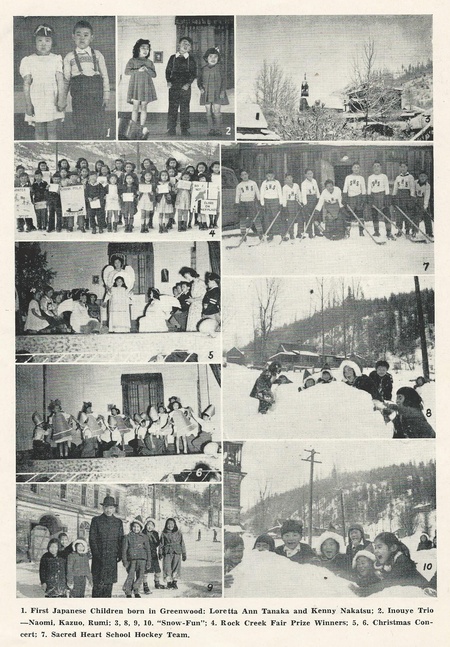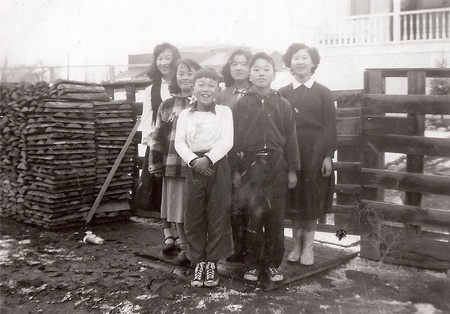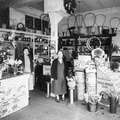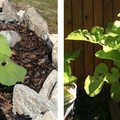WINTER: Winter fun almost equaled summer activities except for the below zero temperature. Skating, sleigh-riding, skiing, building snowman, igloo, shinny hockey, ice carnival and football in the snow kept the children busy.
Looking out the window and the children seeing the snow that fell the night before, they joyously jumped out of bed to put their winter clothing on. That was the scene that repeated most days in the Boundary-Kootenay district of British Columbia.
Back in the fifties, toys were hard to come by so children had to be resourceful. Skis? They were made out of cedar or fir kindling. Children waxed the bottom with candle sticks and skied down the same road where they built their dams. This road led up to the once booming city of Phoenix that became a ghost town around 1920, east of Greenwood. Sacred Heart School was located on the corner of Greenwood Street and Skylark. Therefore, kids at recess and lunch skied down this steep road constantly. After school, they brought out their older brothers’ bobsleds to take a more challenging run. Children, young and old, hauled their bobsleds a mile or so up the hill beyond Raspberry Bend. If some sledders went up too far, they wouldn’t make the turn at the bend. The strategy was to walk just past the hairpin corner. The driver would give the command, “Lean!” All three or four riders had to lean in unison, and hoped that the sled would make the turn. Once past Raspberry Bend, they were home free to go at top speed down to the post office. One older boy engraved his bobsled with a red-hot iron poker on the side of the wooden runner and called it ‘Bulldozer’.
Some children were fortunate enough to own a sled ordered from Eaton’s or Simpson Sears catalogue. They had metal runners and were built for speed. One brand was called Flexible Flyer. By the mid-fifties, most children had these sleighs.
There were minor mishaps like slamming into the telephone posts or hitting a hidden boulder in the snow and somersaulting in the air. This one boy went so fast, he couldn’t stop at the post office and he was going to slide right past the main street of Greenwood. It so happened that a logging truck was slowly moving forward on the hard-packed icy Copper Street. In a flash, the boy sled under the trailer of the logging truck! He lived another day to reminisce about his close call.
Evening was the best time to sleigh ride since so few cars or trucks were on the road. Coming down ‘Phoenix Hill’, there were little pebbles that protruded above the hard-packed snow, sparks from the metal runners was something to see. It was like a special effect. No one had a flashlight on the sled so the sparks helped to identify the sledders coming down. Those who were walking up for another run were on the look-out for vehicles. Whenever a truck came up the road, someone would holler, “Car!” The rubber galoshes sure took a beating when kids had to apply the brakes to slow down their sleds.
One day, I was coming down quite fast past the post office and my teacher happened to be walking by. She tried to stop me or warn me, but too late. I was heading towards the main street and I crashed into the post! Next day in class, I was made an example of dangerous driving!
Skating and shinny hockey kept the children busy all day and night. There was a pond at Greenwood Park for outdoor skating. Some played hockey. Whenever the ice got rough with all the skating, older kids brought their flat shovel to scrape the loose ice. Snow was a hindrance. There was Boundary Creek for skating and hockey too, except it was on an incline so one side had the advantage for hockey. Some of the children trudged a mile or so up the creek and skated down, traversing big boulders and open ice holes. Older boys walked up to the old smelter where there was a pond, but it wasn’t the best spot. People were always looking for fresh ice to skate on. In the evening, children had family passes so they could skate at the Greenwood Arena that was built in the early 1900’s. Here, they played Wall Tag amongst others skating one way. Teenagers could skate like the wind, so younger kids made sure not to crash into them.
Road hockey on hard-packed snow was another activity. Kids with repaired hockey sticks, large branch made into a hockey stick, old 1” x 4” lumber for goalie stick and some with new CCM sticks made up the game. No shooting above the ankle was the only rule. Goalie had cardboard pads and the glove was a trapper’s baseball mitt. One street lamp across from the post office provided light in the evening.
Men’s hockey games were like from the movie, “Slapshot”! Fights, blood, and guts were the menu of the weekend. The natural ice arena got so cold that fans got what seemed like a minor frostbite. In-between periods, there was only one room to warm up. Everyone rushed down to get the best spot. The closer you were to the stove the better. Everyone was huddled like penguins in the Antarctic! The outside person was out of luck. After the game, the pain in your toes was excruciating while you walked down the stairs from the rafters.
One time, my brother wanted to try out in goal. He donned the pads and inserted his aluminum athletic support. Some of the players deliberately aimed for the ‘cup’. After practice, he had several dents. He scratched with a sharp knife, “Wimpy did this, Feb. 3, 1957. No wonder, most kids called it a ‘Nut Cup’. It’s now displayed at the Greenwood Museum!
Most play activities were very informal and spontaneous. Children made snowman and built igloos whenever fresh snow fell. One time, I made an igloo. I rolled many large snowballs and packed them like bricks. The igloo was completed. I placed cardboard for flooring and a candle in the middle, therefore I poked a small hole on top for ventilation. Next morning, I saw yellow stains on my precious igloo. I knew dogs weren’t the suspects because the linear line was too high up!
This kid named Kenji built a ski jump behind his house on a hill. He had real skis. The height could have been about a yard or metre high. It was fun trying to not fall while ski jumping on the plywood that was packed with snow. One boy came with kindling skis. As he skied down fast from the top of the hill, the skis got caught on the edge of the plywood and he went sailing over the jump, falling flat on his face!
Tackle football in the snow was fun too. Kids were bundled up so much that it didn’t hurt to be tackled. The deep snow made it tough for runners. The best time was when the temperature remained below zero for a long time. The deep snow hardened so that a little child like me could run on top of the icy snow. However, as I ran for a sure touchdown, I would hit a soft spot and my one leg sank into the snow. Boom! Everyone tackled me.
Before television, children had so much to do and play. Bringing in sawdust and wood for the stove, shoveling snow off the sidewalk and drying your clothes were daily routines. Making things out of scrap kept everyone busy. Rubbing wax paper on a comic strip and then flashing a light on the white wall with the lights turned off, provided a slideshow of sort. Walkie Talkie was made out of old toilet paper rolls. Kids played Jacks and Pick-up Sticks inside the warm confine of their home.
Christmas and Oshogatsu were the icing on the cake. Life was simpler. Children made their own fun and the activities didn’t cost much. Even though kids did yancha things, most turned out to be productive citizens.
© 2017 Chuck Tasaka









